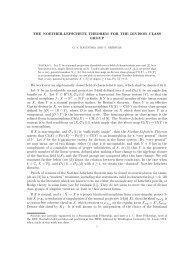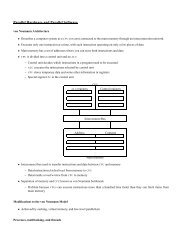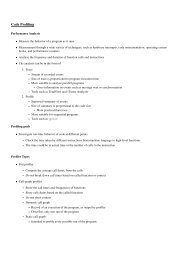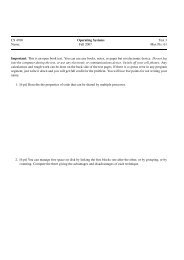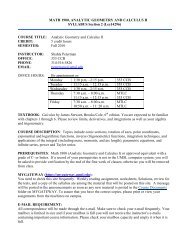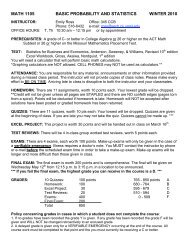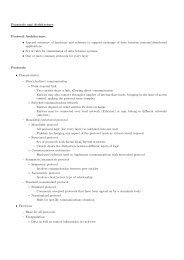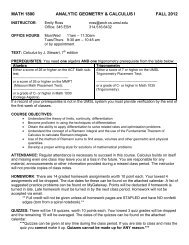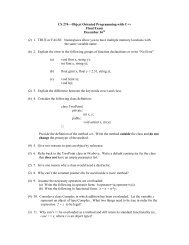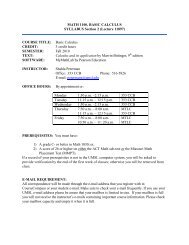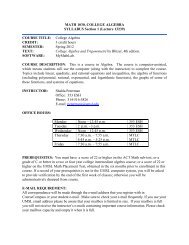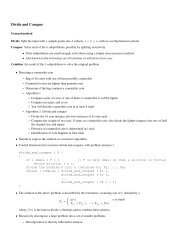here - UMSL : Mathematics and Computer Science - University of ...
here - UMSL : Mathematics and Computer Science - University of ...
here - UMSL : Mathematics and Computer Science - University of ...
Create successful ePaper yourself
Turn your PDF publications into a flip-book with our unique Google optimized e-Paper software.
IEEE TRANS. SIGNAL PROC. 11<br />
Fig. 9.<br />
Left: Original (hexagonal) image; Right: Decomposed image with lowpass filter p<br />
Fig. 10.<br />
Decomposed images with highpass filters q (1) (left) <strong>and</strong> q (2) (right)<br />
A. 6-fold axial symmetry<br />
Let<br />
<strong>and</strong> denote<br />
[ ] [ ] [ 0 1<br />
1 0<br />
1 −1<br />
L 0 = , L<br />
1 0 1 =<br />
, L<br />
1 −1 2 =<br />
0 −1<br />
L 3 = −L 0 , L 4 = −L 1 , L 5 = −L 2 ,<br />
R 1 =<br />
[ 0 1<br />
−1 1<br />
Then for a j, 0 ≤ j ≤ 5, {p k } is symmetric around the symmetry axis S j in Fig. 7 if <strong>and</strong> only if p Lj k = p k ; <strong>and</strong><br />
{p R1 k} is the π 3 (anticlockwise) rotation <strong>of</strong> {p k}.<br />
Observe that<br />
L j = (R 1 ) j L 0 , 0 ≤ j ≤ 5.<br />
Thus, instead <strong>of</strong> considering all L j , 0 ≤ j ≤ 5, we need only consider L 0 , R 1 when we discuss the 6-fold axial<br />
symmetry <strong>of</strong> a filter bank. First we have the following proposition.<br />
Proposition 1: A filter bank {p, q (1) , q (2) } has 6-fold axial symmetry if <strong>and</strong> only if it satisfies<br />
]<br />
.<br />
]<br />
,<br />
(25)<br />
[p, q (1) , q (2) ] T (R1 −T ω) = N 1 (ω)[p, q (1) , q (2) ] T (ω), (26)<br />
[p, q (1) , q (2) ] T (L 0 ω) = N 2 (ω)[p, q (1) , q (2) ] T (ω), (27)<br />
w<strong>here</strong><br />
⎡<br />
N 1 (ω) = ⎣<br />
1 0 0<br />
0 0 e −i(2ω 1+ω 2 )<br />
0 e i(2ω 1+ω 2 )<br />
0<br />
⎤<br />
⎡<br />
⎦ , N 2 (ω) = ⎣<br />
1 0 0<br />
0 e i(ω 1−ω 2 )<br />
0 0 e −i(ω 1−ω 2 )<br />
⎤<br />
⎦ . (28)<br />
Pro<strong>of</strong>. For a filter bank {p, q (1) , q (2) }, let h (1) (ω) = e iω 1 q(1) (ω), h (2) (ω) = e −iω 1 q(2) (ω). Then with the fact<br />
L j = R j 1 L 0, 0 ≤ j ≤ 5, we know {p, q (1) , q (2) } has 6-fold axial symmetry if <strong>and</strong> only if<br />
p(R1 −T ω) = p(L 0 ω) = p(ω), (29)<br />
h (1) ((R1 −T ) 2 ω) = h (1) ((R1 −T ) 4 ω) = h (1) (L 0 ω) = h (1) (ω), (30)<br />
h (2) (−ω) = h (1) (ω). (31)



